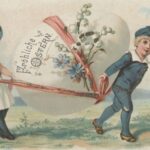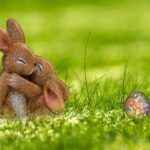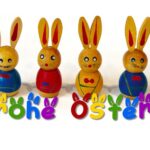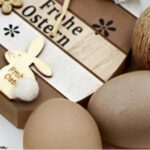
Every Easter, children around the world eagerly anticipate the arrival of the Easter Bunny, who delivers chocolate eggs, sweets, and surprises. But did you know that the Easter Bunny tradition began in Germany?
The Osterhase (Easter Hare) has been a part of German folklore for centuries, originating in pagan fertility symbols and later merging with Christian Easter traditions. But how did a rabbit become one of Easter’s most beloved figures, and why did this tradition spread worldwide?
Let’s dive into the fascinating history of the German Easter Bunny, uncovering its origins, evolution, and cultural significance.
The Origins of the Easter Bunny in Germany
The Osterhase (Easter Hare) was first mentioned in 17th-century German folklore, but its roots go back even further to pre-Christian pagan traditions.
The Pagan Connection: The Hare as a Symbol of Fertility
- In Germanic mythology, hares were sacred animals associated with fertility and renewal.
- The hare was linked to Eostre (or Ostara), the pagan goddess of spring, who was celebrated during springtime festivals.
- Since hares and rabbits reproduce quickly, they symbolized new life and rebirth, concepts that later aligned with Christian Easter themes.
The First Written Record of the Easter Bunny (1682)
- The earliest written mention of the Osterhase comes from 1682, when German scholar Georg Franck von Franckenau described a tradition in which:
- Children built nests for the Easter Hare to lay colorful eggs.
- Well-behaved children found treats, while naughty children received nothing.
- This custom spread through Protestant regions of Germany, particularly in Alsace, the Palatinate, and Hesse.
Read more: The History of Easter in Germany: Pagan Roots to Christian Traditions
How the Easter Bunny Became a German Tradition
While Catholic Germans focused more on Easter lamb symbolism, Protestant families embraced the Osterhase as an alternative to Catholic Easter traditions.
- In 19th-century Germany, the Easter Bunny became a mainstream cultural figure, appearing in children’s stories, illustrations, and holiday decorations.
- German confectioners started making chocolate bunnies, further popularizing the Osterhase as a festive character.
Read more: German Easter Foods: What’s on the Table During Ostern?
How the Easter Bunny Tradition Spread Worldwide
By the 18th century, German immigrants brought the Osterhase tradition to America, where it evolved into the modern Easter Bunny.
The German Easter Bunny in America
- German immigrants in Pennsylvania introduced the Osterhase in the 1700s, where it merged with local customs.
- Over time, the Easter Hare became the Easter Bunny, and instead of nests, children began using baskets.
- The tradition spread to England, France, and other European countries, eventually becoming a global Easter icon.
Easter Bunny Traditions in Germany Today
1. Easter Egg Hunts (Ostereiersuche)
In modern Germany, the Osterhase is responsible for hiding Easter eggs, and children search for them in gardens, parks, and homes.
Read more: Easter Egg Hunts in Germany: A Family Tradition with a Long History
2. Chocolate Bunnies and Marzipan Hares
German bakeries and confectioners create delicious chocolate Easter bunnies and handmade marzipan hares, which are sold at Easter markets.
Read more: German Easter Markets: Where to Find the Best Easter Celebrations
3. Easter Decorations and Osterhase Displays
Throughout Germany, Easter decorations feature hares and rabbits, including:
- Porcelain figurines in traditional Easter markets.
- Hand-painted wooden bunnies in Saxony and Bavaria.
- Giant Easter Bunny displays in major cities like Berlin and Munich.
The Easter Bunny vs. Other German Easter Figures
While the Osterhase is the most famous Easter figure in Germany, other regions have unique variations:
- The Easter Fox (Osterfuchs) – In some parts of Germany, the Osterfuchs (Easter Fox) was once believed to bring eggs before the Osterhase took over.
- The Easter Cuckoo (Osterkuckuck) – In Switzerland, some believe that a cuckoo bird delivers Easter eggs instead of a hare.
- The Easter Stork (Osterstorch) – In certain parts of Germany, storks were once associated with Easter gifts.
The Osterhase (Easter Bunny) is one of Germany’s most enduring Easter traditions, evolving from pagan fertility symbols to a beloved global holiday character.
Whether hiding eggs, delivering chocolate, or decorating Easter markets, the German Easter Bunny continues to delight families across Germany and beyond.
Want to Learn More About German Easter?







